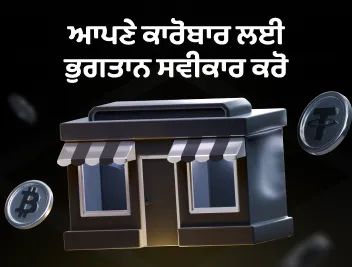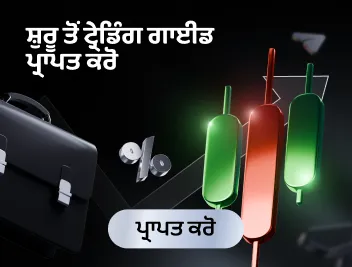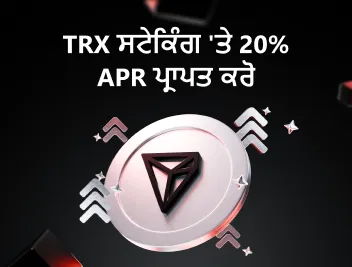
ਆਨ-ਚੇਨ ਬਨਾਮ ਆਫ-ਚੇਨ ਟ੍ਰਾਂਜੈਕਸ਼ਨਃ ਮੁੱਖ ਅੰਤਰ
ਬਲਾਕਚੈਨ ਤਕਨਾਲੋਜੀ ਵਿੱਚ, ਔਫ-ਚੇਨ ਬਨਾਮ ਆਨ-ਚੇਨ ਹੱਲ ਵਿਚਕਾਰ ਅੰਤਰ ਵਿਕੇਂਦਰੀਕ੍ਰਿਤ ਪ੍ਰਣਾਲੀਆਂ ਦੀ ਕੁਸ਼ਲਤਾ, ਮਾਪਯੋਗਤਾ ਅਤੇ ਸੁਰੱਖਿਆ ਦੀ ਡਿਗਰੀ ਨੂੰ ਨਿਰਧਾਰਤ ਕਰਦਾ ਹੈ। ਅੱਜ ਅਸੀਂ ਦੇਖਾਂਗੇ ਕਿ ਆਨ-ਚੇਨ ਅਤੇ ਆਫ-ਚੇਨ ਲੈਣ-ਦੇਣ ਕੀ ਹਨ, ਉਨ੍ਹਾਂ ਦੇ ਫਾਇਦੇ, ਨੁਕਸਾਨ ਅਤੇ ਵੱਖ-ਵੱਖ ਵਿਸ਼ੇਸ਼ਤਾਵਾਂ ਹਨ।
ਆਨ-ਚੇਨ ਅਤੇ ਆਫ-ਚੇਨ ਕੀ ਹੈ?
ਆਨ ਚੇਨ ਬਨਾਮ ਆਫ ਚੇਨ ਕ੍ਰਿਪਟੋ ਟ੍ਰਾਂਜੈਕਸ਼ਨਾਂ ਵਿਚਕਾਰ ਅੰਤਰ ਨਿਰਧਾਰਤ ਕਰਨ ਲਈ, ਪਹਿਲਾਂ ਉਹਨਾਂ ਦੇ ਸੰਕਲਪ ਨੂੰ ਸਮਝਣਾ ਮਹੱਤਵਪੂਰਨ ਹੈ ਅਤੇ ਉਹ ਕੀ ਹਨ। ਇਸ ਲਈ, ਅਸੀਂ ਇਸ ਸਵਾਲ ਦਾ ਜਵਾਬ ਦੇ ਕੇ ਸ਼ੁਰੂ ਕਰਾਂਗੇ ਕਿ ਚੇਨ ਟ੍ਰਾਂਜੈਕਸ਼ਨਾਂ 'ਤੇ ਕੀ ਹਨ. ਇਹ ਸ਼ਬਦ ਉਹਨਾਂ ਟ੍ਰਾਂਜੈਕਸ਼ਨਾਂ ਨੂੰ ਦਰਸਾਉਂਦਾ ਹੈ ਜੋ ਸਿੱਧੇ ਤੌਰ 'ਤੇ ਬਲਾਕਚੈਨ 'ਤੇ ਹੁੰਦੇ ਹਨ, ਜੋ ਕਿ ਇੱਕ ਜਨਤਕ ਤੌਰ 'ਤੇ ਪਹੁੰਚਯੋਗ ਵੰਡਿਆ ਲੇਜ਼ਰ ਹੈ ਜੋ ਹਰੇਕ ਕ੍ਰਿਪਟੋਕੁਰੰਸੀ ਲੈਣ-ਦੇਣ ਨੂੰ ਟਰੈਕ ਕਰਦਾ ਹੈ।
ਆਨ-ਚੇਨ ਲੈਣ-ਦੇਣ ਵਿੱਚ ਡਿਜੀਟਲ ਮੁਦਰਾਵਾਂ ਜਿਵੇਂ ਕਿ BTC, ETH, TRX ਅਤੇ ਹੋਰਾਂ ਨੂੰ ਇੱਕ ਪਤੇ ਤੋਂ ਦੂਜੇ ਪਤੇ ਵਿੱਚ ਟ੍ਰਾਂਸਫਰ ਕਰਨਾ ਸ਼ਾਮਲ ਹੁੰਦਾ ਹੈ ਅਤੇ ਬਲਾਕਚੈਨ 'ਤੇ ਪਾਰਦਰਸ਼ੀ ਅਤੇ ਅਟੱਲ ਤੌਰ 'ਤੇ ਰਿਕਾਰਡ ਕੀਤਾ ਜਾਂਦਾ ਹੈ। ਇਸਦਾ ਮਤਲਬ ਹੈ ਕਿ ਇੰਟਰਨੈਟ ਪਹੁੰਚ ਵਾਲਾ ਕੋਈ ਵੀ ਵਿਅਕਤੀ ਕ੍ਰਿਪਟੋ ਐਕਸਪਲੋਰਰ ਜਿਵੇਂ ਕਿ Cryptomus ਵਿੱਚ ਬਲਾਕਚੈਨ ਦੇ ਅੰਦਰ ਟ੍ਰਾਂਜੈਕਸ਼ਨਾਂ ਨੂੰ ਦੇਖ ਅਤੇ ਪ੍ਰਮਾਣਿਤ ਕਰ ਸਕਦਾ ਹੈ।
ਆਨ-ਚੇਨ ਦੇ ਉਲਟ, ਆਫ-ਚੇਨ ਲੈਣ-ਦੇਣ ਵਿੱਚ ਮੁੱਖ ਬਲਾਕਚੈਨ ਤੋਂ ਬਾਹਰ ਕੋਈ ਵੀ ਵਟਾਂਦਰਾ, ਲੈਣ-ਦੇਣ, ਜਾਂ ਪਰਸਪਰ ਪ੍ਰਭਾਵ ਸ਼ਾਮਲ ਹੁੰਦਾ ਹੈ। ਇਸ ਕਿਸਮ ਦਾ ਲੈਣ-ਦੇਣ, ਜੋ ਬਲਾਕਚੈਨ 'ਤੇ ਰਿਕਾਰਡ ਨਹੀਂ ਕੀਤਾ ਜਾਂਦਾ ਹੈ, ਆਮ ਤੌਰ 'ਤੇ ਤੇਜ਼, ਵਧੇਰੇ ਲਾਗਤ-ਪ੍ਰਭਾਵਸ਼ਾਲੀ ਹੁੰਦਾ ਹੈ, ਅਤੇ ਅਕਸਰ ਮਾਈਕ੍ਰੋਟ੍ਰਾਂਜੈਕਸ਼ਨਾਂ ਦੀ ਇਜਾਜ਼ਤ ਦਿੰਦਾ ਹੈ, ਪਰ ਭਰੋਸੇਯੋਗ ਵਿਚੋਲਿਆਂ 'ਤੇ ਨਿਰਭਰ ਕਰਦਾ ਹੈ। ਭਾਵ, ਮੁੱਖ ਬਲਾਕਚੈਨ 'ਤੇ ਵਾਪਰਨ ਅਤੇ ਇਸ 'ਤੇ ਤੁਰੰਤ ਰਿਕਾਰਡ ਕੀਤੇ ਜਾਣ ਦੀ ਬਜਾਏ, ਔਫ-ਚੇਨ ਕ੍ਰਿਪਟੋਕੁਰੰਸੀ ਲੈਣ-ਦੇਣ ਦੂਜੇ ਤਰੀਕਿਆਂ ਦੁਆਰਾ ਸੈਕੰਡਰੀ ਲੇਅਰਾਂ ਦੁਆਰਾ ਸੰਸਾਧਿਤ ਕੀਤੇ ਜਾਂਦੇ ਹਨ, ਅਤੇ ਅੰਤਮ ਨਤੀਜਾ ਅਜੇ ਵੀ ਅੰਤ ਵਿੱਚ ਮੁੱਖ ਬਲਾਕਚੈਨ 'ਤੇ ਪ੍ਰਕਾਸ਼ਤ ਕੀਤਾ ਜਾਂਦਾ ਹੈ, ਪਰ ਕੁਝ ਸਮੇਂ ਬਾਅਦ।
ਆਨ-ਚੇਨ ਅਤੇ ਆਫ-ਚੇਨ ਟ੍ਰਾਂਜੈਕਸ਼ਨ ਕਿਵੇਂ ਹੁੰਦੇ ਹਨ?
ਚੇਨ ਟ੍ਰਾਂਜੈਕਸ਼ਨਾਂ 'ਤੇ
-
ਲੈਣ-ਦੇਣ ਦੀ ਸ਼ੁਰੂਆਤ ਅਤੇ ਸੰਚਾਲਨ: ਭਾਵੇਂ ਇਹ ਇੱਕ ਆਫ ਚੇਨ ਬਨਾਮ ਚੇਨ ਟ੍ਰਾਂਜੈਕਸ਼ਨ ਹੋਵੇ, ਉਹਨਾਂ ਦੇ ਸੰਚਾਲਨ ਵਿੱਚ ਪਹਿਲਾ ਕਦਮ ਸ਼ੁਰੂਆਤ ਹੈ। ਅਜਿਹਾ ਕਰਨ ਲਈ, ਭੇਜਣ ਵਾਲਾ, ਆਪਣੀ ਨਿੱਜੀ ਕੁੰਜੀ ਦੀ ਵਰਤੋਂ ਕਰਦੇ ਹੋਏ, ਆਪਣੇ ਵਾਲਿਟ ਤੋਂ ਕਿਸੇ ਹੋਰ ਉਪਭੋਗਤਾ ਦੇ ਵਾਲਿਟ ਪਤੇ 'ਤੇ ਕ੍ਰਿਪਟੋ ਦੀ ਇੱਕ ਨਿਸ਼ਚਿਤ ਮਾਤਰਾ ਟ੍ਰਾਂਸਫਰ ਕਰਦਾ ਹੈ। ਹਸਤਾਖਰ ਕੀਤੇ ਟ੍ਰਾਂਜੈਕਸ਼ਨ ਨੂੰ ਫਿਰ ਨੈੱਟਵਰਕ 'ਤੇ ਭੇਜਿਆ ਜਾਂਦਾ ਹੈ ਅਤੇ ਮਲਟੀਪਲ ਨੋਡਸ ਦੁਆਰਾ ਸਵੀਕਾਰ ਕੀਤਾ ਜਾਂਦਾ ਹੈ।
-
ਮੈਮਪੂਲ ਅਤੇ ਮਾਈਨਿੰਗ: ਅੱਗੇ, ਟ੍ਰਾਂਜੈਕਸ਼ਨ ਨੂੰ ਇੱਕ ਮੈਮਪੂਲ ਵਿੱਚ ਜੋੜਿਆ ਜਾਂਦਾ ਹੈ, ਜੋ ਕਿ ਗੈਰ-ਪੁਸ਼ਟੀ ਟ੍ਰਾਂਜੈਕਸ਼ਨਾਂ ਲਈ ਇੱਕ ਅਸਥਾਈ ਭੰਡਾਰ ਹੈ। ਉੱਥੇ ਇਹ ਇੱਕ ਬਲਾਕ ਵਿੱਚ ਸ਼ਾਮਲ ਹੋਣ ਦੀ ਉਡੀਕ ਕਰ ਰਿਹਾ ਹੈ, ਇਹ ਬਣਾਉਣ ਲਈ ਕਿ ਕਿਹੜੇ ਮਾਈਨਰ ਮੇਮਪੂਲ ਤੋਂ ਲੈਣ-ਦੇਣ ਇਕੱਠੇ ਕਰਦੇ ਹਨ। ਅਤੇ ਜੋ ਵੀ ਪਹਿਲਾਂ ਸਫਲਤਾਪੂਰਵਕ ਸਹੀ ਨੋਨਸ ਅਤੇ ਇਸਦੇ ਅਨੁਸਾਰੀ ਹੈਸ਼ ਨੂੰ ਲੱਭਦਾ ਹੈ, ਉਹ ਬਲਾਕਚੈਨ ਵਿੱਚ ਬਲਾਕ ਨੂੰ ਜੋੜਦਾ ਹੈ ਅਤੇ ਇਸਨੂੰ ਪ੍ਰਮਾਣਿਤ ਕਰਦਾ ਹੈ। ਇਸ ਵਿੱਚ ਕੁਝ ਸਮਾਂ ਲੱਗ ਸਕਦਾ ਹੈ। ਉਦਾਹਰਨ ਲਈ, ਚੇਨ ਟ੍ਰਾਂਜੈਕਸ਼ਨਾਂ 'ਤੇ ਬਿਟਕੋਇਨ ਲਈ ਪੁਸ਼ਟੀ ਕਰਨ ਦਾ ਸਮਾਂ ਆਮ ਤੌਰ 'ਤੇ 10 ਮਿੰਟ ਹੁੰਦਾ ਹੈ।
-
ਬਲਾਕਚੈਨ ਰਿਕਾਰਡਿੰਗ: ਸਫਲ ਪੁਸ਼ਟੀ ਤੋਂ ਬਾਅਦ, ਲੈਣ-ਦੇਣ ਨੂੰ ਸਥਾਈ ਤੌਰ 'ਤੇ ਬਲਾਕਚੈਨ 'ਤੇ ਰਿਕਾਰਡ ਕੀਤਾ ਜਾਂਦਾ ਹੈ ਅਤੇ ਬਲਾਕਚੈਨ ਐਕਸਪਲੋਰਰ ਵਿੱਚ ਦੇਖਣ ਅਤੇ ਟਰੈਕ ਕਰਨ ਲਈ ਹਰ ਕਿਸੇ ਲਈ ਉਪਲਬਧ ਹੈ। ਅਤੇ ਹੁਣ ਬਦਲਿਆ ਨਹੀਂ ਜਾ ਸਕਦਾ।
ਆਫ ਚੇਨ ਲੈਣ-ਦੇਣ
ਜਦੋਂ ਅਸੀਂ ਹਾਲ ਹੀ ਵਿੱਚ ਆਨ ਚੇਨ ਬਨਾਮ ਆਫ ਚੇਨ ਟ੍ਰਾਂਜੈਕਸ਼ਨਾਂ ਦੇ ਸੰਕਲਪਾਂ ਨੂੰ ਦੇਖਿਆ, ਤਾਂ ਅਸੀਂ ਮਹਿਸੂਸ ਕੀਤਾ ਕਿ ਆਫ-ਚੇਨ ਟ੍ਰਾਂਜੈਕਸ਼ਨਾਂ ਨੂੰ ਪ੍ਰਮਾਣਿਤ ਕਰਨ ਲਈ ਵੱਖ-ਵੱਖ ਵਿਧੀਆਂ ਦੀ ਵਰਤੋਂ ਕੀਤੀ ਜਾਂਦੀ ਹੈ। ਇਹ ਖਾਸ ਪ੍ਰੋਟੋਕੋਲ ਜਾਂ ਤਕਨਾਲੋਜੀ 'ਤੇ ਨਿਰਭਰ ਕਰਦੇ ਹਨ, ਅਤੇ ਇਸ ਲਈ ਅਜਿਹੇ ਲੈਣ-ਦੇਣ ਲਈ ਇੱਕ ਤੋਂ ਵੱਧ ਵਿਧੀ ਹੈ। ਸਾਈਡਚੇਨ ਅਜਿਹੇ ਹੱਲਾਂ ਦੀ ਇੱਕ ਉਦਾਹਰਨ ਹੈ, ਅਤੇ ਅਸੀਂ ਦੇਖਾਂਗੇ ਕਿ ਇਸਦੇ ਕੇਸ ਸਟੱਡੀ ਦੀ ਵਰਤੋਂ ਕਰਕੇ ਆਫ-ਚੇਨ ਲੈਣ-ਦੇਣ ਕਿਵੇਂ ਹੁੰਦੇ ਹਨ।:
-
ਸਾਈਡਚੇਨ: ਪਹਿਲਾਂ, ਉਪਭੋਗਤਾ ਇੱਕ ਸਾਈਡਚੇਨ ਬਣਾਉਂਦੇ ਜਾਂ ਸੈੱਟ ਕਰਦੇ ਹਨ - ਇੱਕ ਵੱਖਰਾ ਬਲਾਕਚੈਨ ਨੈਟਵਰਕ ਜੋ ਮੁੱਖ ਬਲਾਕਚੈਨ ਨਾਲ ਇੰਟਰੈਕਟ ਕਰ ਸਕਦਾ ਹੈ। ਉਪਭੋਗਤਾ ਇੱਕ ਦੋ-ਪੱਖੀ ਡੇਟਾ ਬਾਈਡਿੰਗ ਵਿਧੀ ਨੂੰ ਲਾਗੂ ਕਰਦਾ ਹੈ ਜੋ ਮੁੱਖ ਬਲਾਕਚੈਨ ਅਤੇ ਸਾਈਡਚੇਨ ਦੇ ਵਿਚਕਾਰ ਡਿਜੀਟਲ ਸੰਪਤੀਆਂ ਨੂੰ ਸੁਤੰਤਰ ਰੂਪ ਵਿੱਚ ਲਿਜਾਣ ਵਿੱਚ ਮਦਦ ਕਰਦਾ ਹੈ।
-
ਆਫ-ਚੇਨ ਟ੍ਰਾਂਜੈਕਸ਼ਨ: ਇਸ ਤੋਂ ਇਲਾਵਾ, ਉਪਭੋਗਤਾ ਮੁੱਖ ਬਲਾਕਚੈਨ ਤੋਂ ਕ੍ਰਿਪਟੋ ਦੀ ਇੱਕ ਨਿਸ਼ਚਿਤ ਮਾਤਰਾ ਨੂੰ ਇੱਕ ਸਮਾਰਟ ਕੰਟਰੈਕਟ ਵਿੱਚ ਲੌਕ ਕਰਦਾ ਹੈ। ਇਹ ਆਫ-ਚੇਨ ਟ੍ਰਾਂਜੈਕਸ਼ਨ ਦੌਰਾਨ ਸੰਪਤੀਆਂ ਨੂੰ ਸੁਰੱਖਿਅਤ ਕਰਦਾ ਹੈ ਅਤੇ ਜਮਾਂਦਰੂ ਵਜੋਂ ਕੰਮ ਕਰਦਾ ਹੈ। ਅੱਗੇ ਇੱਕ ਸਾਈਡਚੇਨ ਦੀ ਵਰਤੋਂ ਕਰਨਾ ਹੈ, ਜੋ ਇਹ ਯਕੀਨੀ ਬਣਾਉਂਦਾ ਹੈ ਕਿ ਆਫ-ਚੇਨ ਲੈਣ-ਦੇਣ ਤੇਜ਼ੀ ਨਾਲ ਸੰਸਾਧਿਤ ਹੁੰਦੇ ਹਨ ਅਤੇ ਘੱਟ ਫੀਸਾਂ ਹੁੰਦੀਆਂ ਹਨ। ਅਸੀਂ ਇਸ ਬਾਰੇ ਅਤੇ ਔਫਚੈਨ ਬਨਾਮ ਆਨਚੈਨ ਦੀਆਂ ਹੋਰ ਵਿਸ਼ੇਸ਼ਤਾਵਾਂ ਬਾਰੇ ਗੱਲ ਕਰਾਂਗੇ।
-
ਅੰਤਿਮ ਬੰਦੋਬਸਤ: ਫਿਰ ਉਪਭੋਗਤਾ ਇੱਕ ਔਨ-ਚੇਨ ਟ੍ਰਾਂਜੈਕਸ਼ਨ ਸ਼ੁਰੂ ਕਰਦਾ ਹੈ ਜਦੋਂ ਉਹ ਆਫ-ਚੇਨ ਬੰਦੋਬਸਤ ਨੂੰ ਅੰਤਿਮ ਰੂਪ ਦੇਣਾ ਚਾਹੁੰਦੇ ਹਨ ਅਤੇ ਮੁੱਖ ਬਲਾਕਚੇਨ 'ਤੇ ਵਾਪਸ ਜਾਣਾ ਚਾਹੁੰਦੇ ਹਨ। ਇਸ ਬਿੰਦੂ 'ਤੇ, ਸਾਈਡਚੇਨ ਵਿੱਚ ਆਫ-ਚੇਨ ਟ੍ਰਾਂਜੈਕਸ਼ਨਾਂ ਦਾ ਨਤੀਜਾ ਆਨ-ਚੇਨ ਟ੍ਰਾਂਜੈਕਸ਼ਨ ਵਿੱਚ ਪ੍ਰਤੀਬਿੰਬਤ ਹੁੰਦਾ ਹੈ ਅਤੇ ਬਲੌਕ ਕੀਤੀਆਂ ਸੰਪਤੀਆਂ ਨੂੰ ਮੁੱਖ ਬਲਾਕਚੈਨ 'ਤੇ ਆਨ-ਚੇਨ ਟ੍ਰਾਂਜੈਕਸ਼ਨ ਦੁਆਰਾ ਦੁਬਾਰਾ ਉਪਲਬਧ ਕਰਾਇਆ ਜਾਂਦਾ ਹੈ।

ਆਨ-ਚੇਨ ਅਤੇ ਆਫ-ਚੇਨ ਟ੍ਰਾਂਜੈਕਸ਼ਨਾਂ ਦੇ ਲਾਭ/ਨੁਕਸਾਨ
| ਲੈਣ-ਦੇਣ | ਲਾਭ | ਨੁਕਸਾਨ | |
|---|---|---|---|
| ਆਨ-ਚੇਨ | ਲਾਭ- ਬਲਾਕਚੈਨ ਅਤੇ ਵਿਚੋਲਿਆਂ ਦੀ ਅਣਹੋਂਦ ਇਹ ਯਕੀਨੀ ਬਣਾਉਂਦੀ ਹੈ ਕਿ ਸਾਰੇ ਲੈਣ-ਦੇਣ ਦੇ ਵੇਰਵੇ ਇੱਕ ਬਹੀ ਵਿੱਚ ਦਰਜ ਕੀਤੇ ਗਏ ਹਨ, ਅਤੇ ਨੈੱਟਵਰਕ ਵਿੱਚ ਸਾਰੇ ਭਾਗੀਦਾਰਾਂ ਲਈ ਜਵਾਬਦੇਹੀ ਨੂੰ ਉਤਸ਼ਾਹਿਤ ਕਰਦਾ ਹੈ - ਉਹ ਸੁਰੱਖਿਅਤ ਹਨ ਕਿਉਂਕਿ ਜਨਤਕ ਬਲਾਕਚੈਨ 'ਤੇ ਰਿਕਾਰਡ ਇਨਕ੍ਰਿਪਟਡ ਹਨ ਅਤੇ ਉਹਨਾਂ ਨਾਲ ਛੇੜਛਾੜ ਨਹੀਂ ਕੀਤੀ ਜਾ ਸਕਦੀ ਜਦੋਂ ਤੱਕ ਕਿ ਇੱਕ ਬਹੁਗਿਣਤੀ ਭਾਗੀਦਾਰ ਇਸ ਨਾਲ ਸਹਿਮਤ ਹਨ - ਬਲਾਕਚੈਨ ਤਕਨਾਲੋਜੀ ਵਿੱਚ ਮੌਜੂਦ ਵਿਸ਼ੇਸ਼ਤਾਵਾਂ ਅਤੇ ਵਿਧੀਆਂ ਇਹ ਯਕੀਨੀ ਬਣਾਉਂਦੀਆਂ ਹਨ ਕਿ ਇਹ ਲੈਣ-ਦੇਣ ਸੁਰੱਖਿਅਤ ਹਨ ਅਤੇ ਨੈੱਟਵਰਕ ਅਸਫਲਤਾਵਾਂ ਲਈ ਘੱਟ ਸੰਵੇਦਨਸ਼ੀਲ ਹਨ - ਉੱਚ-ਮੁੱਲ ਵਾਲੇ ਲੈਣ-ਦੇਣ ਲਈ ਸੁਵਿਧਾਜਨਕ ਜਿੱਥੇ ਸੁਰੱਖਿਆ ਅਤੇ ਨਤੀਜਿਆਂ ਦੀ ਨਿਸ਼ਚਤਤਾ ਸਭ ਤੋਂ ਮਹੱਤਵਪੂਰਨ ਹੈ | ਨੁਕਸਾਨ- ਨੈੱਟਵਰਕ ਲੋਡ ਅਤੇ ਕਤਾਰ ਵਿੱਚ ਪੁਸ਼ਟੀ ਕੀਤੇ ਜਾਣ ਦੀ ਉਡੀਕ ਕਰ ਰਹੇ ਲੈਣ-ਦੇਣ ਦੀ ਗਿਣਤੀ 'ਤੇ ਨਿਰਭਰ ਕਰਦੇ ਹੋਏ, ਉਹਨਾਂ ਵਿੱਚ ਲੰਮੀ ਦੇਰੀ ਹੋ ਸਕਦੀ ਹੈ - ਬਦਕਿਸਮਤੀ ਨਾਲ, ਲੈਣ-ਦੇਣ ਦੇ ਪੈਟਰਨਾਂ ਦੀ ਜਾਂਚ ਕਰਕੇ, ਭਾਗੀਦਾਰ ਦੀ ਪਛਾਣ ਨੂੰ ਅੰਸ਼ਕ ਤੌਰ 'ਤੇ ਨਿਰਧਾਰਤ ਕਰਨਾ ਸੰਭਵ ਹੈ - ਉੱਚ ਫੀਸਾਂ ਅਤੇ ਹੌਲੀ ਪ੍ਰਕਿਰਿਆ ਦੇ ਕਾਰਨ ਨਿਯਮਤ ਮਾਈਕ੍ਰੋਟ੍ਰਾਂਜੈਕਸ਼ਨਾਂ ਲਈ ਅਵਿਵਹਾਰਕ ਹੋਵੇਗਾ | |
| ਆਫ-ਚੇਨ | ਲਾਭ- ਬਹੁਤ ਸਾਰੇ ਉਪਭੋਗਤਾਵਾਂ ਲਈ ਉਪਲਬਧ ਅਤੇ ਅਕਸਰ ਟ੍ਰਾਂਸਫਰ ਅਤੇ ਮਾਈਕ੍ਰੋਟ੍ਰਾਂਜੈਕਸ਼ਨਾਂ ਲਈ ਆਦਰਸ਼ ਜਿੱਥੇ ਗਤੀ ਮਹੱਤਵਪੂਰਨ ਹੁੰਦੀ ਹੈ - ਮੁੱਖ ਚੇਨ ਤੋਂ ਲੋਡ ਨੂੰ ਉਤਾਰ ਕੇ ਅਤੇ ਉੱਚ ਥ੍ਰੁਪੁੱਟ ਪ੍ਰਦਾਨ ਕਰਕੇ, ਆਫ-ਚੇਨ ਟ੍ਰਾਂਜੈਕਸ਼ਨ-ਆਧਾਰਿਤ ਹੱਲ ਬਲਾਕਚੈਨ ਦੀ ਮਾਪਯੋਗਤਾ ਵਿੱਚ ਸੁਧਾਰ ਕਰਦੇ ਹਨ - ਕਿਉਂਕਿ ਨਾ ਤਾਂ ਮਾਈਨਰ ਅਤੇ ਨਾ ਹੀ ਭਾਗੀਦਾਰ ਨੂੰ ਲੈਣ-ਦੇਣ ਦੀ ਪੁਸ਼ਟੀ ਕਰਨ ਦੀ ਲੋੜ ਹੁੰਦੀ ਹੈ, ਇਹਨਾਂ ਲੈਣ-ਦੇਣ ਲਈ ਆਮ ਤੌਰ 'ਤੇ ਟ੍ਰਾਂਜੈਕਸ਼ਨ ਫੀਸਾਂ ਦੀ ਲੋੜ ਨਹੀਂ ਹੁੰਦੀ ਹੈ - ਸਾਡੇ ਔਨ-ਚੇਨ ਬਨਾਮ ਆਫ-ਚੇਨ ਵਿਸ਼ਲੇਸ਼ਣ ਤੋਂ, ਅਸੀਂ ਮਹਿਸੂਸ ਕੀਤਾ ਕਿ ਬਾਅਦ ਵਾਲੇ ਭਾਗੀਦਾਰਾਂ ਨੂੰ ਵਧੇਰੇ ਸੁਰੱਖਿਆ ਅਤੇ ਗੁਮਨਾਮਤਾ ਪ੍ਰਦਾਨ ਕਰਦੇ ਹਨ ਕਿਉਂਕਿ ਵੇਰਵੇ ਜਨਤਕ ਤੌਰ 'ਤੇ ਖੁਲਾਸਾ ਨਹੀਂ ਕੀਤਾ ਜਾਂਦਾ | ਨੁਕਸਾਨ- ਆਫ-ਚੇਨ ਹੱਲਾਂ ਵਿੱਚ ਹੋਰ ਪ੍ਰਣਾਲੀਆਂ ਦੇ ਨਾਲ ਸੀਮਿਤ ਅੰਤਰ-ਕਾਰਜਸ਼ੀਲਤਾ ਹੋ ਸਕਦੀ ਹੈ - ਔਨ ਚੇਨ ਬਨਾਮ ਆਫ ਚੇਨ ਗਵਰਨੈਂਸ ਵਿੱਚ ਕੇਂਦਰੀਕ੍ਰਿਤ ਪਾਰਟੀਆਂ ਸ਼ਾਮਲ ਹੋ ਸਕਦੀਆਂ ਹਨ, ਬਲਾਕਚੈਨ ਤਕਨਾਲੋਜੀ ਦੀ ਵਿਕੇਂਦਰੀਕ੍ਰਿਤ ਪ੍ਰਕਿਰਤੀ ਦੇ ਉਲਟ - ਨੈੱਟਵਰਕ ਤੋਂ ਬਾਹਰ ਟ੍ਰਾਂਜੈਕਸ਼ਨਾਂ ਲਈ ਤੀਜੀ ਧਿਰ ਦੀ ਵਰਤੋਂ ਦੀ ਅਗਵਾਈ ਕਰ ਸਕਦੀ ਹੈ ਧੋਖਾਧੜੀ ਜਾਂ ਕ੍ਰਿਪਟੋ ਚੋਰੀ ਦੇ ਜੋਖਮਾਂ ਲਈ |
ਆਨ-ਚੇਨ ਬਨਾਮ ਆਫ-ਚੇਨ: ਕਿਹੜਾ ਬਿਹਤਰ ਹੈ?
ਆਨ ਚੇਨ ਬਨਾਮ ਆਫ ਚੇਨ ਬਲਾਕਚੈਨ ਟ੍ਰਾਂਜੈਕਸ਼ਨਾਂ ਵਿਚਕਾਰ ਅੰਤਰ ਨੂੰ ਸਮਝਣਾ ਸਿਰਫ ਪਹਿਲਾ ਕਦਮ ਹੈ। ਇਹ ਨਿਰਧਾਰਿਤ ਕਰਨ ਲਈ ਕਿ ਕੀ ਕ੍ਰਿਪਟੋ ਆਨ ਚੇਨ ਜਾਂ ਆਫ ਚੇਨ ਬਿਹਤਰ ਹੈ ਹਰ ਕਿਸਮ ਦੀਆਂ ਵਿਸ਼ੇਸ਼ਤਾਵਾਂ ਦੀ ਜਾਂਚ ਕਰਨਾ ਵੀ ਸ਼ਾਮਲ ਹੈ ਅਤੇ ਇਹ ਤੁਹਾਡੀਆਂ ਜ਼ਰੂਰਤਾਂ 'ਤੇ ਨਿਰਭਰ ਕਰਦਾ ਹੈ।
ਜੇ ਤੁਸੀਂ ਉਸ ਕਿਸਮ ਦੇ ਵਿਅਕਤੀ ਹੋ ਜੋ ਸੁਰੱਖਿਆ ਦੀ ਭਾਲ ਕਰ ਰਹੇ ਹੋ ਅਤੇ ਜੋਖਮ ਨੂੰ ਘੱਟ ਕਰਨ ਦੀ ਕੋਸ਼ਿਸ਼ ਕਰ ਰਹੇ ਹੋ, ਤਾਂ ਆਨ-ਚੇਨ ਲੈਣ-ਦੇਣ ਸਭ ਤੋਂ ਵਧੀਆ ਹਨ। ਹਾਲਾਂਕਿ, ਉੱਚੀਆਂ ਫੀਸਾਂ ਅਤੇ ਹੌਲੀ ਬੰਦੋਬਸਤਾਂ ਲਈ ਤਿਆਰ ਰਹੋ। ਜੇਕਰ ਸਕੇਲੇਬਿਲਟੀ ਅਤੇ ਸਪੀਡ ਤੁਹਾਡੇ ਲਈ ਸਭ ਤੋਂ ਪਹਿਲਾਂ ਆਉਂਦੇ ਹਨ, ਤਾਂ ਆਫ-ਚੇਨ ਟ੍ਰਾਂਜੈਕਸ਼ਨਾਂ ਨੂੰ ਦੇਖੋ।
ਆਮ ਤੌਰ 'ਤੇ, ਆਨ ਚੇਨ ਬਨਾਮ ਆਫ ਚੇਨ ਟ੍ਰਾਂਜੈਕਸ਼ਨਾਂ ਦੋ ਵੱਖ-ਵੱਖ ਤਕਨਾਲੋਜੀਆਂ ਹਨ ਜੋ, ਉਹਨਾਂ ਦੀਆਂ ਵਿਲੱਖਣ ਵਿਸ਼ੇਸ਼ਤਾਵਾਂ ਦੇ ਕਾਰਨ, ਕ੍ਰਿਪਟੋ ਸੰਪਤੀਆਂ ਨਾਲ ਕੰਮ ਕਰਨ ਲਈ ਲੋੜੀਂਦੇ ਸਾਧਨ ਪੇਸ਼ ਕਰਦੀਆਂ ਹਨ। ਸਿਰਫ ਸਮਾਂ ਹੀ ਦੱਸੇਗਾ ਕਿ ਭਵਿੱਖ ਵਿੱਚ ਕਿਸ ਦੀ ਜਿੱਤ ਹੋਵੇਗੀ।
ਲੇਖ ਨੂੰ ਦਰਜਾ ਦਿਓ








ਟਿੱਪਣੀਆਂ
0
ਤੁਹਾਨੂੰ ਇੱਕ ਟਿੱਪਣੀ ਪੋਸਟ ਕਰਨ ਲਈ ਲਾਗਇਨ ਹੋਣਾ ਚਾਹੀਦਾ ਹੈ